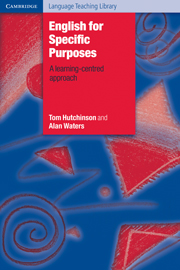Section 2 - Course design
Published online by Cambridge University Press: 03 May 2010
Summary
I keep six honest serving-men.
(They taught me all I knew.)
Their names are What and Why and When
And How and Where and Who.
(Rudyard Kipling)We concluded the previous section by stating that ESP is an approach to language teaching which aims to meet the needs of particular learners. This means in practice that much of the work done by ESP teachers is concerned with designing appropriate courses for various groups of learners. Thus, whereas course design plays a relatively minor part in the life of the General English teacher – courses here usually being determined either by tradition, choice of textbook or ministerial decree – for the ESP teacher, course design is often a substantial and important part of the workload.
Designing a course is fundamentally a matter of asking questions in order to provide a reasoned basis for the subsequent processes of syllabus design, materials writing, classroom teaching and evaluation.
We need to ask a very wide range of questions: general and specific, theoretical and practical. Some of these questions will be answered (at least in part) by research; others will rely more on the intuition and experience of the teacher; yet others will call on theoretical models. We can use Kipling's ‘honest serving men’ to outline the basic questions. We need to know:
Why does the student need to learn?
Who is going to be involved in the process? This will need to cover not just the student, but all the people who may have some effect on the process: teachers, sponsors, inspectors etc.
- Type
- Chapter
- Information
- English for Specific Purposes , pp. 21 - 23Publisher: Cambridge University PressPrint publication year: 1987



